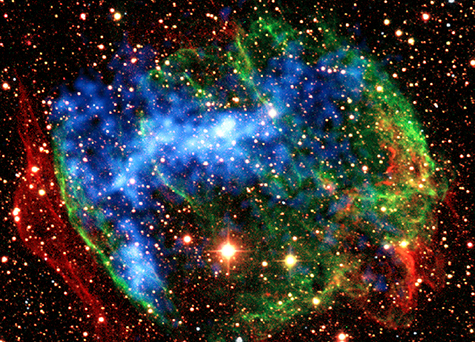
Shrinivas Kulkarni, PhD, the John D. and Catherine T. McArthur Professor of Astronomy and Planetary Science at the California Institute of Technology, will deliver the sixth annual
Robert M. Walker Distinguished Lecture at 7 p.m. Thursday, Nov. 7.
Kulkarni, who leads the Palomar Transient Factory, an astronomical wide-field survey designed to search for transient and variable sources, will speak on the dynamic universe.
The talk, hosted by the McDonnell Center for the Space Sciences, will take place in Whitaker Hall, Room 100, on the Danforth Campus of Washington University
in St. Louis. It is free and open to the public.
People noticed that “new stars” (stella nova) would sometimes appear in the heavens more than 1,000 years ago, Kulkarni said, but the study of cosmic explosions began in earnest less than 100 years ago. Over time, astronomers have come to appreciate the central role of supernovae in synthesizing new elements, making possible life as we know it.
He will go on to describe the dynamic universe revealed by the Palomar Transient Factory, an automated two-telescope system designed to detect transient and variable astronomical sources. The factory, which saw first light in 2008, typically finds a transient source outside our galaxy every 20 minutes and a galatic variable every 10 minutes. Quary it has snared include supernovae, novae, catacylsmic variable stars and tidal disruption flares, among many others.
Kulkarni is the director of optical observatories at the California Institute of Technology, including the Palomar Observatory (California) and the W.M. Keck Observatory (Hawaii). His primary interests are the study of compact objects (neutron stars and gamma-ray bursts) and the search for extra-solar planets through interferometric and adaptive techniques.
The McDonnell Center, in
Arts & Sciences, is sponsoring the lecture as part of the Robert M.
Walker Distinguished Lecture Series in memory of Robert M. Walker, PhD,
the center’s inaugural director from 1975-99.
Walker was a
pioneering physicist who shaped research in
the space sciences worldwide. The Walker
lecture series was established by Ramanath Cowsik, PhD, the James S. McDonnell Professor of Space Sciences and director of the McDonnell Center, in 2008.
The McDonnell Center, established in 1975 through a gift
from aerospace pioneer James S. McDonnell, is a consortium of WUSTL
faculty, research staff and students primarily from the departments of
Earth and Planetary Sciences and Physics, both in Arts & Sciences,
who are working on the cutting edge of space research.
As part of the lecture series, Kulkarni also will deliver a colloquium,
titled “There is More Room Sideways,” at 4 p.m. Wednesday, Nov. 6, in Crow Hall, Room 204.
In the colloquium, he will talk about advances in semiconductors, detectors and methodology that permit astronomers to conduct pioneering research with smaller budgets.
Refreshments will preceed the colloquium, which is free and open to the public.
For more information on the talks, contact Trecia Stumbaugh at trecia@wustl.edu or (314) 935-5332.